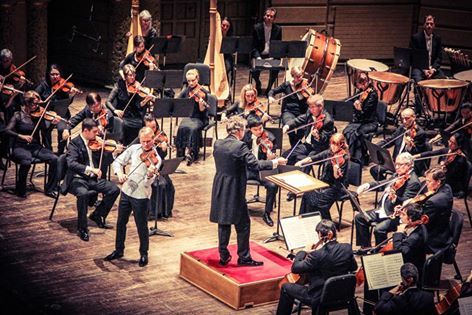 Canada Haydn, Beethoven and Bartok: Dale Barltrop (violin), Vancouver Symphony Orchestra, Thomas Sondergaard (conductor), Orpheum Theatre, Vancouver, BC, 16.2.2015 (GN)
Canada Haydn, Beethoven and Bartok: Dale Barltrop (violin), Vancouver Symphony Orchestra, Thomas Sondergaard (conductor), Orpheum Theatre, Vancouver, BC, 16.2.2015 (GN)
Haydn: Symphony No. 99 in E-flat major
Bartok: Violin Concerto No. 1, Op. posth.
Beethoven: Symphony No. 2 in D major, Op. 36
This was a rather special concert, featuring VSO concertmaster Dale Barltrop’s annual foray into concerto ‘rarities’– this time Bartok’s youthful First Violin Concerto — plus the debut of young conductor, Thomas Sondergaard, who has been lavishly praised for his performances with the BBC National Orchestra of Wales and the Royal Scottish Symphony Orchestra. It was an interesting combination, and none of the performances came out as particularly standard in any sense.
Bartok’s First Violin Concerto (1908) is a product of his early period, originally dedicated to violinist Stefi Geyer, who rejected it. While purists might insist that the composer never really wanted the work to enter the public domain, its two existing movements eventually surfaced in 1958 and were championed by no less than David Oistrakh. Since the work dates from before Bartok and Zoltan Kodaly’s enterprising quest to explore authentic Hungarian folk music, there are still questions about exactly how it should be performed, although the Two Portraits, Op. 5 offers some guide. While Bartok’s compositional palette still looks backward to the lush romanticism of Richard Strauss, Oistrakh and later Soviets, such as Gidon Kremer, have often taken the lyrical opening Andante as much more than a simple melancholic expression; rather as a testimony to a subtle and painful inner turmoil, finding a kinship perhaps with the bleak musings of Shostakovich’s Violin Concerto No. 1. This approach can be quite moving — but how faithful is it?
Dale Barltrop clearly wants to treat this movement in a less intense way, as an enticing stream of bittersweet lyricism that conveys sadness but is not burdened by it. His opening was stronger and more positive and his expression gave the work a distinctive freedom and momentum. With the violinist’s admirably pure tone, his refined articulation, and his ability to control the longer line, I think that this approach did find considerable beauty that is seldom explored. It also revealed some of the innocence of the composer, his feelings less hidden than they were eventually and exhibiting a healthy sense of fantasy. But was this unmistakably Bartok? Well, lovely as it was, perhaps not really. The closest parallel here might be the dreamy, bittersweet lyricism in Prokofiev’s First Violin Concerto, eventually pushing out as far as Barber and Korngold.
The following Allegro is much more animated and at times powerful. It was articulated with a sure dramatic sense, the conductor’s rhythmic discipline and colour standing out alongside the violinist’s more cutting statements. But again, I would be hard pressed to guess that Bartok wrote this music. Rhythms were often given a strict neoclassical point (in the spirit of Stravinsky), but Bartok’s rhythms even then usually have a raw, earthy ‘pull’ to them, as one can discern from the Suite for Orchestra, Op. 4. Nonetheless, everything was executed with such conviction that I found this approach rather persuasive as an alternative to think about.
Sondergaard’s Haydn is indeed ‘big-band’ Haydn, and the conductor achieved a strongly-resilient outcome in Symphony No. 99. Great attention was paid to articulating the sharply-etched string counterpoint, and to placing dramatic accents in the right places. The only difficulty is this is one of the composer’s most charming and genial symphonies, as many from Sir Thomas Beecham forward have shown. The key to the charm is the delightful winds, which always have something to say in their subtle interaction with the strings. But not in the first two movements here: Sondergaard simply failed to coax much sparkle or ingenuity from them at all. The Minuet carried on this somewhat severe approach, the carefree innocence of the Trio going for little, while the Finale was undeniably exciting with all its accents and powerful thrust. I have no doubt that this approach did capture some of the robust buoyancy and truculence in the composer’s make-up, at times reminding me a little of Roy Goodman or Sir Simon Rattle. Overall though, it seemed too heavy and conspicuously light on wit for this work in particular.
If Sondergaard’s Haydn might have sounded a bit like Beethoven, then his following Beethoven Second Symphony perhaps sounded more like the composer’s Seventh, with strong weight and drama throughout and a slow movement that actually mimicked the rich string shaping of the latter’s. My reactions were very similar to above: What happened to all the wit and play in this fresh youthful work? The first movement turned out sort of brazen and brash, but it did introduce one innovation that I had not heard before. In the opening repeated interchanges between the strings and horns, the conductor alternated between having the horn notes first muted and then non-muted, over and over again. I have no idea what this was about. It was in the final two movements that sheer force took over, virtually everything emphatic and laboured. I was not sure if this degree of force was really intended: sometimes it looked like the orchestra and the conductor were not always in complete agreement, since ensemble was not perfect. Nevertheless, the finale effectively sought the same white heat and volcanic weight that one finds in the finale of the Seventh (recall Carlos Kleiber). Unfortunately, I found this just loud and painfully unremitting, with obsessively-emphatic timpani. It will be interesting to hear how Sondergaard actually does Beethoven’s Seventh when he gets to it.
Geoffrey Newman
Previously published in a slightly different form on http://www.vanclassicalmusic.com
